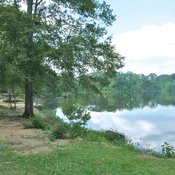This week, the U.S. Army Corps of Engineers, Vicksburg District, closed their four-year study of Pearl River flood solutions in the Jackson metro, issuing a press release that was unambiguously titled: "Study Finds Levee Plan Best Option For Jackson Metro."
Back in 2003, the Rankin-Hinds Pearl River Flood and Drainage Control District (the "Levee Board") and the Corps jointly funded a study to consider a comprehensive levee plan as well as a plan to dam the Pearl River and create two lakes for flood control and economic development. That "two lakes" plan eventually became the "Lefleur's Lakes" plan.
In recent months and years, the Levee Board wrangled with other plans to impound the river and create lakesthe often-tweaked Two Lakes plan proposed by oilman John McGowan and a "one lake" plan borne of a 2007 planning charrette. The one-lake plan was a compromise that would flood the lower parts of the river in Jackson to create a water feature near downtown.
In a fairly straightforward rebuke of any lakes plan, the Corps' release said, "The U.S. Army Corps of Engineers has concluded that sufficient studies have determined that variations of any lake impoundment or impoundments would not be economically feasible or environmentally acceptable."
Now the Levee Board has a decision in front of itwaste more money and time chasing a lakes plan, or begin the process of finally implementing flood management on the Pearl River in the Jackson metro.
The Obama administration will take the environmental concerns seriously. And with Democrats in control of Congress, the earmark that McGowan may have once gotten to fund this monster of a project isn't going to happen.
And without the Corps blessing, you're sitting ducks for the environmental litigation that will tie this thing up for yearsif not decades.
The good news is that building levees doesn't mean that there are no economic-development opportunities within the project; we believe very promising eco-devo is made possible by the right-of-way created by a new levee system on the Pearl, along with federal programs such as Rails-to-Trails.
If we turn the Pearl into a green transportation corridorbiking, hiking, walking and runningand offer access to the river for recreational use, we'll see a huge economic boon, particularly as we continue to attempt to attract young, professional workers, and families to work in the area's hospitals, universities and bio-technology startups. We might even see condo projects crop up on the outskirts of the Pearl Greenway, offering features like bike storage, walking paths and high floors overlooking the river and adjacent parks.
As the 30th anniversary of the Easter Flood passes with no solution, the Levee Board must be responsible and move on the levees, and we encourage everyone to continue the discussion about the Pearl River Greenway project.
Previous Comments
- ID
- 153912
- Comment
FWIW, you made google news with this one.
- Author
- Pilgrim
- Date
- 2009-12-02T16:07:07-06:00



Comments
Use the comment form below to begin a discussion about this content.
comments powered by Disqus